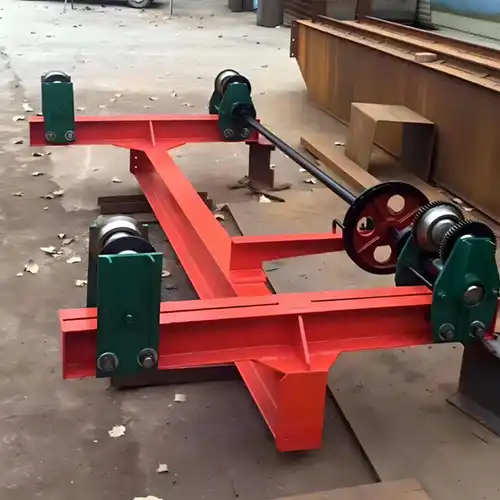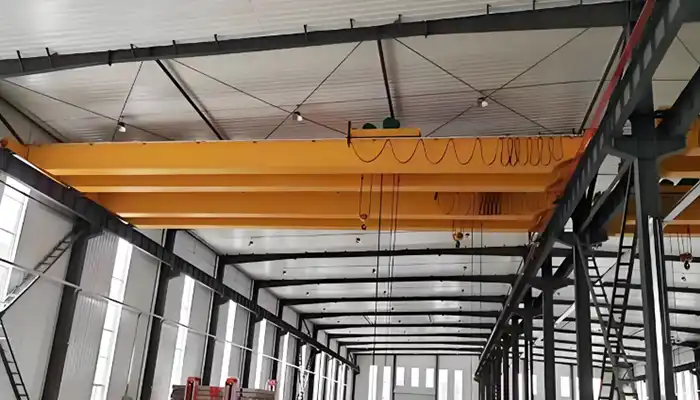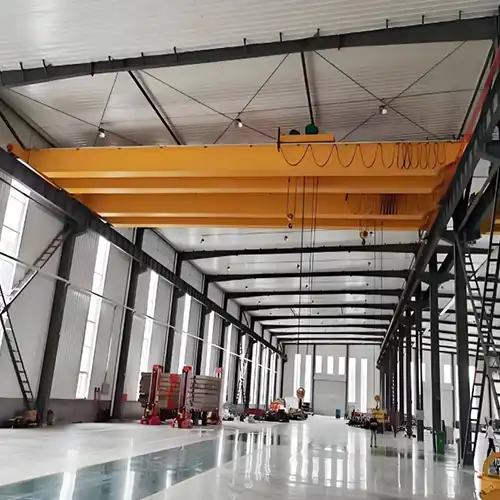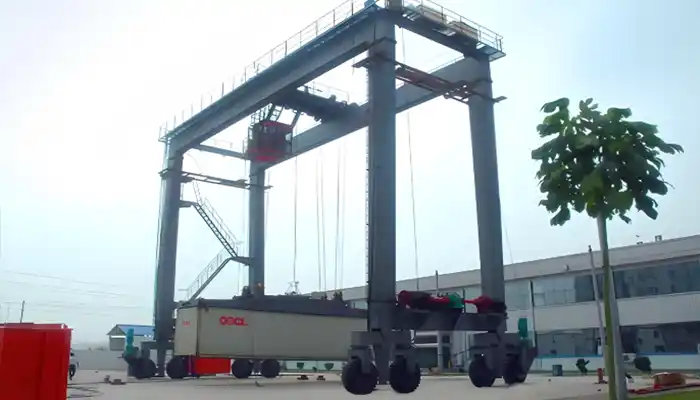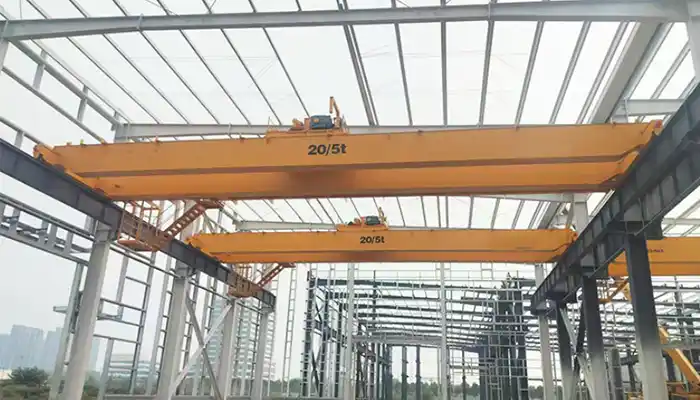
Choosing the Right Electric Overhead Crane for Mold Handling
Choosing Right Crane for Mold Handling in Glass Manufacturing
Overhead Mold Handling Crane Solutions for Every Production Scale
Importance of Mold Handling in Glass Manufacturing
Mold handling is a key part of making glass. Molds shape molten glass into products like bottles, jars, and decorative items. Proper mold handling is essential to keep production running smoothly and ensure the molds are not damaged during transportation or placement.
- Molds are often heavy and delicate.
- They need to be moved with care to avoid damage.
- Proper handling helps keep production efficient and the final product high-quality.
Challenges in Mold Handling
Mold handling cranes comes with several challenges. Let’s look at the main ones:
- High Temperatures: Molds are exposed to molten glass, so the equipment used must withstand high heat.
- Varied Sizes and Weights: Molds come in many shapes and sizes, making them tricky to move around in tight spaces.
- Precision Required: Moving molds accurately is important to avoid damaging them or slowing down production.
These challenges mean that mold handling requires careful planning and the right equipment.
Why Choosing the Right Crane Matters
The right crane makes a huge difference in mold handling. It improves efficiency, safety, and mold quality. Here’s why:
- Efficiency: A good crane moves molds quickly and accurately, keeping production on track.
- Safety: Cranes with safety features, like emergency stops and load sensors, protect both workers and molds.
- Quality: Molds need to be handled carefully to avoid cracks or chips. The right crane ensures they are moved gently and precisely.
Choosing the right crane helps prevent delays and keeps the production line running smoothly.
Impact on Production Scalability
As your glass production grows, so will your need for better mold handling. A crane that works well for small-scale operations might not be enough for larger ones.
- Handling More Molds: As production increases, you’ll need to handle more molds, which requires a stronger crane.
- Preventing Delays: A crane that can scale with your business helps avoid bottlenecks in production.
By choosing a crane that can grow with your needs, you’ll save time and money as your business expands.
Types of Variable Speed Overhead Cranes for Mold Handling
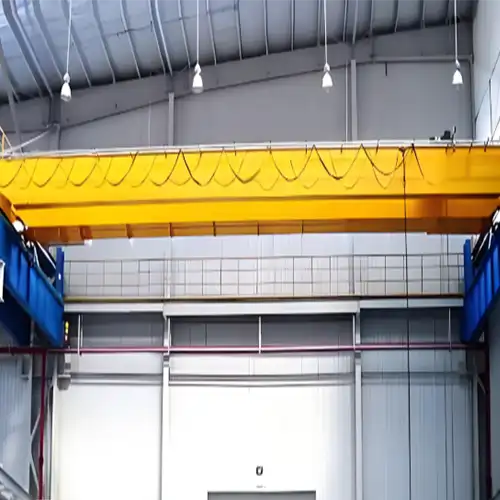
Overhead Cranes: Key Features, Benefits, and Typical Applications
Overhead cranes are commonly used for mold handling in glass manufacturing because of their ability to cover large areas while providing precise control. These cranes move along tracks mounted above the production floor, making them ideal for handling heavy molds in spacious facilities.
Key Features:
- Variable Speed Control: Provides smooth movement for delicate or heavy molds.
- High Load Capacity: Able to handle heavy mold weights (typically 5 to 40 tons).
- Safety Features: Includes anti-sway systems and load limiters to protect both the mold and workers.
Benefits:
- Efficiency: Fast, precise mold handling reduces downtime.
- Space-Saving: Mounted above the floor, they save valuable production space.
- Adaptability: Suitable for various applications in glass manufacturing, from small-scale to large operations.
Typical Applications:
- Used for medium to large-scale glass production facilities, handling molds weighing between 5 to 40 tons.
- Ideal for high-volume production lines where molds need to be moved quickly between different stages of glass forming.
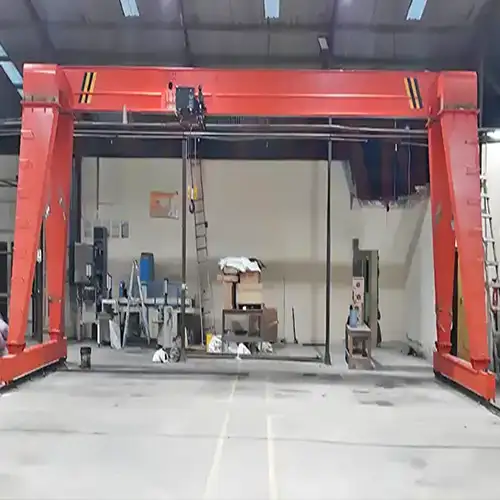
Gantry Cranes: Best for Larger-Scale Operations
Gantry cranes are particularly suited for large glass manufacturing plants that require mobility and the ability to lift heavier molds. These cranes are supported by legs rather than mounted overhead, giving them flexibility to move across expansive areas.
Advantages in Larger-Scale Operations:
- Heavy Lifting Capacity: Gantry cranes can lift up to 50 tons and are ideal for handling large and heavy molds.
- Wide Coverage: These cranes are capable of covering large areas, making them perfect for expansive production floors or outdoor glass manufacturing sites.
- Mobility: Can be moved easily across different parts of the production facility.
Typical Applications:
- Used in large glass plants where molds vary in size and weight, with typical lifting capacities between 10 and 50 tons.
- Ideal for outdoor environments or when handling oversized molds that need to be moved across large distances, such as in glass casting or furnace loading.
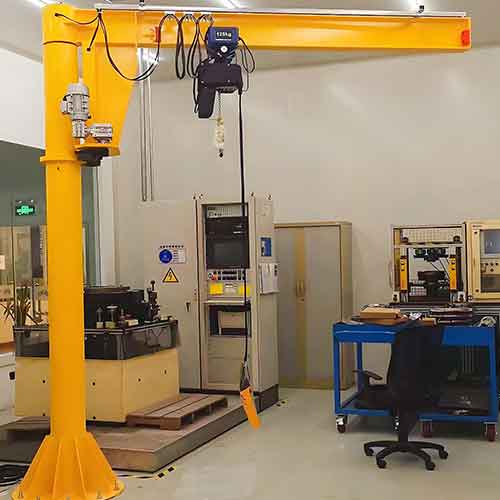
Jib Cranes: Suitable for Small to Medium-Scale Glass Production
Jib cranes are smaller and more compact, making them ideal for small to medium-scale glass production. These cranes are designed with a rotating arm that allows for precise mold placement within a limited space.
Compact and Versatile Solutions:
- Capacity: Typically range from 1 to 10 tons.
- Space-Efficient: Suitable for smaller production facilities or areas with limited space.
- Flexible Operation: Capable of precise mold handling in tight spaces, such as assembly areas or mold cooling sections.
Typical Applications:
- Used in small to medium-sized glass plants for handling molds that weigh 1 to 10 tons.
- Ideal for batch processing or pre-forming areas, where molds need to be moved short distances but with high precision.
Specialized Cranes for Mold Handling: Custom Crane Solutions
For glass manufacturers with specific mold handling needs, specialized cranes can be custom-designed to meet the exact requirements of the production process. These cranes are built to provide precision, enhanced safety, and efficiency in mold transport.
Custom Crane Solutions:
- Capacity: Can handle mold weights ranging from 5 tons to 30 tons, depending on the design.
- Tailored Design: Features such as mold-specific attachments, temperature control, and precise speed adjustments ensure molds are handled with care.
- Safety Features: Advanced safety systems are included to minimize the risk of mold damage or accidents during lifting and transportation.
Typical Applications:
- Custom-designed cranes are used in specialized glass production processes, such as glass molding or furnace loading, where molds are exposed to high temperatures or need to be transported with extreme care.
- These cranes are often found in premium glass manufacturing settings where mold integrity is critical, such as in art glass production or high-end container glass manufacturing, with molds weighing anywhere from 5 to 30 tons.
Each type of crane offers distinct benefits suited to different glass manufacturing operations, whether for large-scale factories or more compact, high-precision needs.
Key Considerations for Selecting the Right Crane
Production Scale: Small, Medium, or Large
The size of your operation directly influences the type of crane you need.
Small-Scale Operations:
- Suitable for lighter molds (1-10 tons).
- Recommended Crane Type: Compact jib cranes or smaller overhead cranes.
- Key Feature: Precision in tight spaces.
Medium-Scale Operations:
- Molds in the range of 5-20 tons.
- Recommended Crane Type: Overhead cranes with variable speed control.
- Key Feature: Flexibility and moderate lifting capacity.
Large-Scale Operations:
- Larger molds (20-50 tons or more).
- Recommended Crane Type: Heavy-duty gantry or large overhead cranes.
- Key Feature: High lifting capacity and mobility over large areas.
Each scale requires tailored crane solutions to meet the needs of mold handling and production efficiency.
Load Capacity: Determining Mold Handling Requirements
Knowing the weight of the molds you're handling is crucial when selecting a crane.
Small Molds (1-10 tons):
- Recommended Crane Type: Jib cranes or smaller overhead cranes.
- Benefit: Suitable for handling light molds with precision.
Medium Molds (10-20 tons):
- Recommended Crane Type: Overhead cranes with higher capacities.
- Benefit: Provides versatility for moderate loads.
Large Molds (20-50 tons or more):
- Recommended Crane Type: Gantry cranes or heavy-duty overhead cranes.
- Benefit: Capable of handling heavy, bulky molds safely.
Ensure that the crane's load capacity matches the weight and size of the molds to avoid overloading and ensure safety.
Space and Layout Constraints: Choosing the Right Crane for Your Plant
The layout of your plant plays a big role in crane selection. Factors like available floor space, headroom, and accessibility are key.
Headroom:
- Low Ceilings: Opt for low-profile cranes like jib cranes or compact overhead cranes.
- High Ceilings: Standard overhead cranes are ideal for larger clearance.
Floor Space:
- Limited Space: Jib cranes or small overhead cranes are ideal for tight spaces.
- Large Plant Areas: Gantry cranes are a good option for expansive areas where mobility is needed.
Accessibility:
- Limited Movement Area: Compact cranes such as jib cranes.
- Wide Plant Layouts: Gantry or overhead cranes that can move molds across large areas efficiently.
Choosing a crane that fits your facility's layout and space ensures smoother operations and better workflow.
Speed and Efficiency: Optimizing Production Timelines
The speed at which a crane operates directly affects your production efficiency.
Importance of Speed:
- Faster crane movements minimize mold handling time, improving productivity.
- Precise speed control is critical for delicate mold handling, preventing damage during quick movements.
Optimizing Workflow:
- Variable Speed Cranes: Ideal for handling different mold sizes and ensuring both fast transport and careful movement.
- Recommended Crane Types: Overhead cranes for controlled speed adjustments, gantry cranes for large-scale operations, and jib cranes for fast, precise handling in confined areas.
Selecting a crane with proper speed control ensures you meet production deadlines while maintaining mold quality.
Crane Design Features for Mold Handling
Durability and Strength: Key Materials and Design Features for Heavy-Duty Handling
For efficient mold handling, the crane must be designed to handle heavy and often large molds under demanding conditions. The durability and strength of the crane play a crucial role in ensuring smooth operations over time.
Materials Used for Durability:
- Steel is the most common material used for crane structures due to its strength and ability to withstand heavy loads.
- Alloyed steels may be used in areas subject to high stresses or extreme wear conditions.
- High-strength steel components ensure that the crane can handle the weight of large molds without compromising safety.
Design Features for Heavy-Duty Handling:
- Reinforced structure ensures the crane can lift and transport heavy molds without flexing or bending.
- Heavy-duty wheels and rail systems support large loads and allow smooth movement of cranes across long distances within the plant.
- Strong lifting hooks and spreaders designed to accommodate the weight and shape of molds ensure reliability during lifting and transport.
These design features help ensure the crane can handle mold handling tasks day after day, even in the most demanding environments of glass manufacturing.
Anti-Corrosion Features: Addressing Exposure to High Temperatures and Glass-Related Materials
Mold handling in glass manufacturing involves exposure to high temperatures, chemicals, and sometimes harsh environmental conditions. Anti-corrosion features in crane design are crucial to ensure longevity and prevent degradation.
Corrosion-Resistant Materials:
- Stainless Steel: Often used in components exposed to high temperatures and corrosive materials to prevent rust and degradation.
- Galvanized Coatings: Applied to steel crane components to provide an additional layer of protection against corrosion.
- Paints with Anti-Corrosion Properties: Specialized coatings are used to protect the crane from chemical exposure, moisture, and extreme temperatures.
Design Considerations:
- Heat-Resistant Components: Parts of the crane that come into direct contact with molds are designed to withstand the high temperatures associated with glass production.
- Sealed Bearings and Lubrication Systems: These prevent rust and maintain smooth operation even in harsh conditions.
These anti-corrosion features extend the crane’s service life and reduce maintenance costs, ensuring consistent performance in challenging environments.
Precision and Control Systems: Technology Integration for Precise Mold Movement
Handling molds in glass manufacturing requires extreme precision to avoid damage to both the molds and the products. The crane’s control systems play a pivotal role in providing this precision.
Advanced Control Systems:
- Variable Speed Drives: These allow precise adjustments to the crane’s speed, ensuring slow, controlled movement when handling fragile or large molds.
- Load Sensing Systems: Ensure the crane operates within its weight capacity, automatically adjusting the lifting speed to match the mold weight.
- Remote Control Systems: Allow operators to adjust crane movements from a distance, improving safety and precision in mold handling.
Precision Features:
- Fine-Tuned Lift and Travel Movements: The crane's lift system is designed to move molds gently, preventing sudden jolts or vibrations that could damage sensitive molds.
- Positioning Systems: These guide the crane to precise positions during mold loading and unloading, increasing the accuracy and reliability of operations.
These technologies ensure that your crane moves molds efficiently, safely, and precisely, even in high-pressure production settings.
Safety Features in Crane Selection
Load Stability and Protection: Ensuring Safe Handling of Molds
Safety during mold handling is a top priority, especially when lifting heavy or fragile molds. Cranes designed for this purpose include several features to ensure that the load remains stable and secure throughout the lifting and transportation process.
Load Securing Systems:
- Hook Locks or Lifting Clamps: These mechanisms ensure that molds are securely attached to the crane and won’t accidentally slip or fall.
- Spreaders or Sling Systems: Evenly distribute the load to prevent uneven strain on the crane and the mold. This ensures both the mold and crane’s stability during lifts.
Load Monitoring:
- Load Cells integrated into the crane’s lifting system monitor the weight of the mold, ensuring it doesn’t exceed the crane’s rated capacity.
- Overload Protection Systems: Automatically shut off the crane if the load exceeds a safe threshold, preventing accidents and damage.
These features work together to keep the mold securely in place and prevent accidents caused by unstable loads.
Anti-Sway Systems: Preventing Mold Damage During Transit
When handling large or heavy molds, swaying can lead to accidents or mold damage. Cranes used for mold handling incorporate anti-sway technology to ensure smooth and controlled movement.
Anti-Sway Technology:
- Active Sway Control Systems: These systems monitor and reduce any swinging of the load during transit by adjusting the crane’s movements in real-time.
- Soft Start and Stop Systems: Gradual acceleration and deceleration help prevent sudden jerks or swaying that could damage delicate molds.
Benefits of Anti-Sway Systems:
- Protects Mold Integrity: Prevents molds from swinging uncontrollably, reducing the risk of mold damage.
- Improves Safety: Keeps both the crane operator and nearby workers safe by ensuring the crane maintains control over the load at all times.
These systems are critical for ensuring that molds are handled with precision, reducing the risk of damage during transport.
Emergency Stops and Sensors: Safeguarding Workers and Equipment
Crane operations involve risks, and it is essential to have emergency mechanisms in place to protect workers and prevent accidents.
Emergency Stop Systems:
- Immediate Shutdown: Cranes are equipped with emergency stop buttons that allow operators to immediately halt the crane’s operation in case of an emergency. This is particularly important when something goes wrong, such as an overload or sudden obstacle.
- Automatic Emergency Stops: Sensors on the crane can detect irregularities like sudden movements or proximity to an obstruction, automatically activating an emergency stop to prevent further damage.
Safety Sensors:
- Proximity Sensors: Detect when objects or workers are too close to the crane, preventing accidents by halting the crane’s movement if someone enters a danger zone.
- Load Sensors: Monitor the weight of the load to ensure the crane is not lifting beyond its capacity, preventing overload-related accidents.
These safety features ensure that both workers and equipment are protected from accidents or malfunction, making the crane safer to operate in high-risk environments.
Case Studies: Successful Crane Applications in Glass Manufacturing
Small-Scale Operation
Challenge: A small glass manufacturing plant needed a crane system that could handle light to medium mold weights, operate within tight spaces, and ensure precision without requiring a large investment.
Solution: The plant opted for a compact jib crane with a load capacity of up to 5 tons.
Key Features:
- Space-Saving Design: The jib crane's small footprint made it ideal for the confined space of the plant.
- Ease of Operation: The crane was equipped with a manual or electric hoist, offering a balance between cost and efficiency.
- Precision: With fine-tuned movement control, the crane provided the accuracy needed to handle smaller glass molds safely.
Outcome: This solution allowed the plant to achieve higher productivity without the need for a more expensive, larger system. The small-scale crane met the operational demands while keeping costs low and operations efficient.
Medium-Scale Production
Challenge: A medium-sized glass manufacturer needed to handle multiple molds simultaneously, with an emphasis on quick turnaround times and flexibility for different mold sizes and weights.
Solution: The manufacturer installed an overhead crane with variable speed control and a capacity of 10-20 tons, allowing for the handling of both light and heavy molds.
Key Features:
- Multi-Mold Handling: The crane could handle multiple smaller molds or one larger mold at a time.
- Variable Speed Control: Enabled precise movements at various speeds, ensuring safe and efficient handling of molds in different production stages.
- Improved Workflow: The crane’s design enhanced workflow by allowing fast and controlled movements between production zones.
Outcome: The crane improved production efficiency by reducing mold handling time, increasing throughput, and minimizing the risk of mold damage. The manufacturer achieved greater operational flexibility and enhanced production capacity.
Large-Scale Production
Challenge: A large glass manufacturing plant producing large molds for architectural glass faced issues with handling heavy and oversized molds across an expansive production floor, with high-speed operation and safety requirements.
Solution: The plant invested in a gantry crane system with a capacity of up to 50 tons, designed for mass production and capable of covering the entire production area.
Key Features:
- Heavy-Duty Design: The crane’s robust construction enabled it to handle the heaviest molds with ease.
- Advanced Control Systems: Equipped with automated load positioning and anti-sway technology, the crane ensured precise mold handling with minimal operator input.
- Massive Coverage: The gantry crane’s mobility allowed it to cover a large area, facilitating efficient mold transport across different sections of the facility.
Outcome: The installation of the gantry crane led to significant improvements in production efficiency. The plant was able to reduce cycle times, increase throughput, and ensure consistent quality in mold handling for large-scale glass production.
These case studies highlight the importance of selecting the right crane based on production scale. By choosing the appropriate crane, glass manufacturers can optimize efficiency, reduce operational costs, and enhance the quality of mold handling throughout their facilities.
Conclusion
Summary of Key Points: Recap of Considerations and Solutions
Choosing the right crane for mold handling in glass manufacturing is critical to ensuring efficient and safe operations. Here’s a quick recap of the key considerations and solutions:
- Production Scale: Whether your operation is small, medium, or large, the crane must align with your specific production needs. From compact jib cranes for small operations to robust gantry cranes for large-scale production, selecting the right type of crane is essential.
- Load Capacity and Stability: Understanding the weight and size of molds helps determine the crane's load capacity. Features such as load monitoring, securing systems, and anti-sway technology ensure safe and stable mold handling.
- Space and Layout: The design of your facility dictates the type of crane you need. Overhead cranes are ideal for large spaces, while jib cranes are better suited for compact areas.
- Safety and Precision: Safety features like emergency stops, anti-sway systems, and precision control ensure that both the mold and the workers are protected. Advanced control systems allow for accurate and smooth mold movements.
Each crane type—overhead, gantry, jib, and specialized—offers unique advantages depending on production scale, mold size, and operational goals. The right selection is key to optimizing productivity and safety in mold handling.
Making the Final Decision: How to Choose Based on Your Unique Needs
When selecting a crane for mold handling, consider the following steps:
- Assess Your Production Needs: Determine the scale of your operation—whether you're handling small, medium, or large molds—and choose a crane that matches these needs.
- Evaluate Facility Space: Consider the available floor space and headroom in your plant. A jib crane might be best for tight spaces, while an overhead crane or gantry crane could suit larger facilities.
- Review Safety Requirements: Make sure the crane you choose is equipped with essential safety features like load protection, anti-sway systems, and emergency stops.
- Factor in Maintenance and Durability: Select a crane that offers durability and longevity to minimize downtime and maintenance costs. Anti-corrosion features are essential in high-temperature environments.
By considering these factors, you can make an informed decision that enhances your production capabilities and meets the demands of your glass manufacturing operation.

